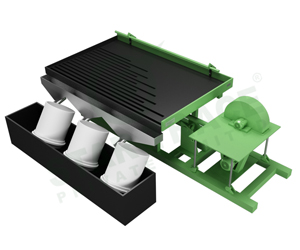
Laboratory Concentrating Table

Wilfley table is most widely used shaking table. It consists of a slightly inclined deck on to which feed, bout 25% solids by weight, is introduced at the feed box and is distributed along the feed launder, wash water is distributed along the balance length of the feed launder. The table is given shaking motion longitudinally using a slow forward stoke and a rapid return, which causes the mineral particles to move along the deck parallel to the direction of motion. In this table the riffles run parallel with the long axis and are tapered form the maximum height on the feed side till they die out near the opposite side, parts of which is left smooth. Where the riffles stand high, a certain amount of eddying movement occurs, aiding the stratification and jigging action between the riffles. As the load of material is jerked across the table, the upper most layer is swept or rolled over into the riffled gap. In this way the upper most layer of sand is repeatedly move over to riffle after riffle after riffle until it leaves the deck. As the water film is thinnest while climbing over the riffle, any suspended solids drop into the trough and move crosswise as a result of the mechanical shaking movement.
Capacity:
Model |
Capacity kg/Hr |
Wash Water |
Deck Size |
Motor |
Pulley |
Stroke |
Standard |
570-5770 |
22-90 |
1830 x 4570 |
1.2 |
240-300 |
18-30 |
Oversize |
750-6600 |
22-90 |
2130 x 4570 |
1.2 |
240-300 |
18-30 |
